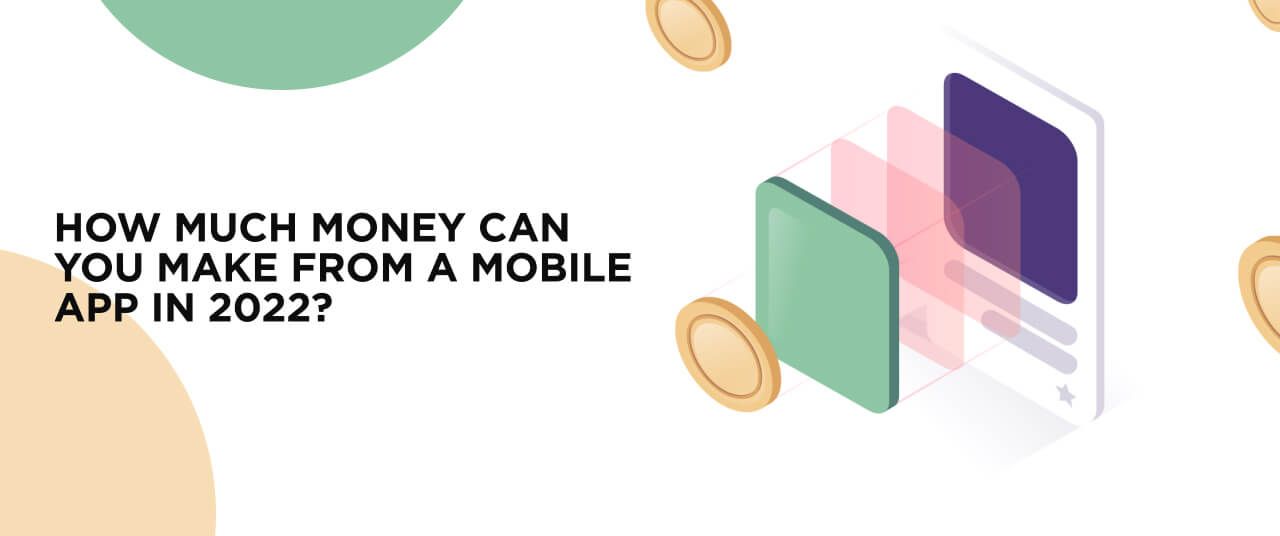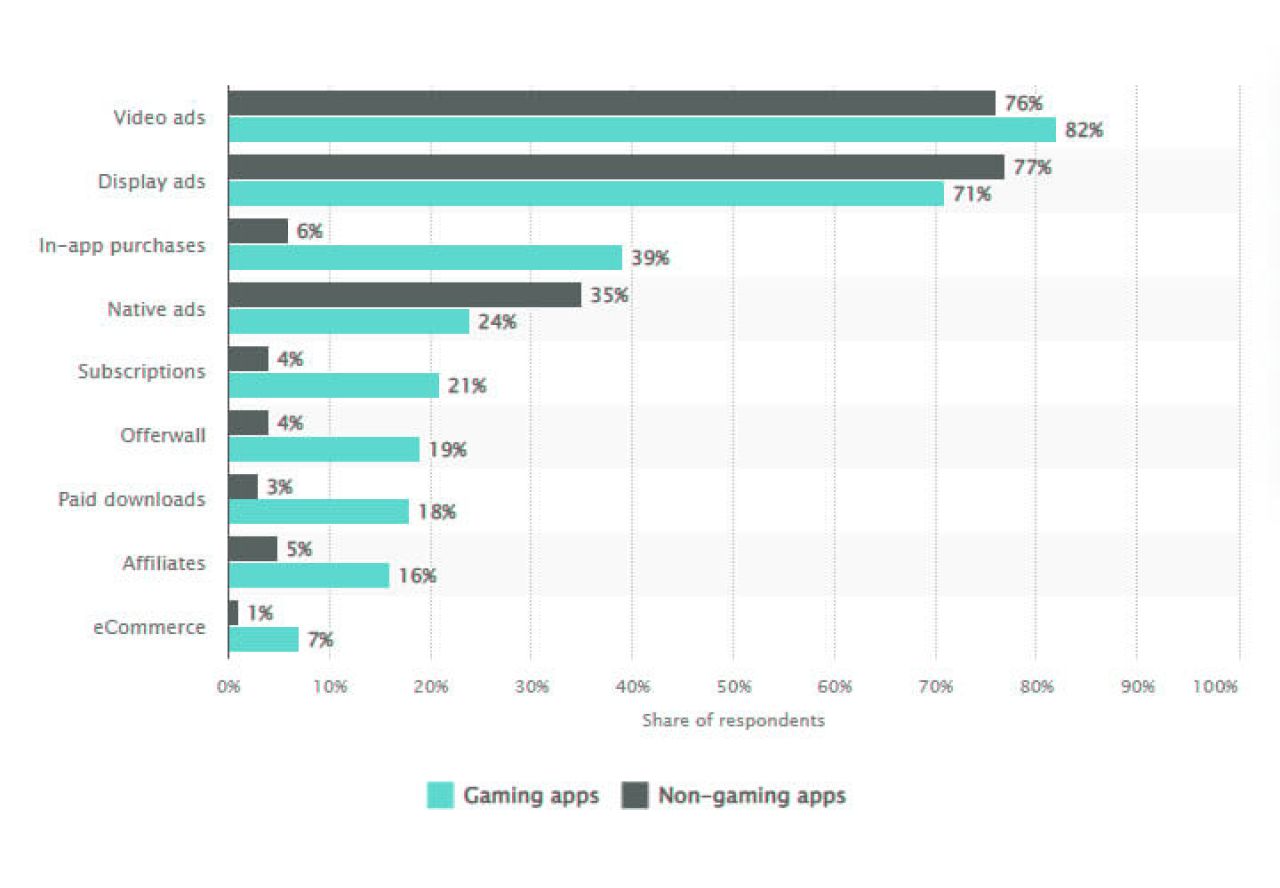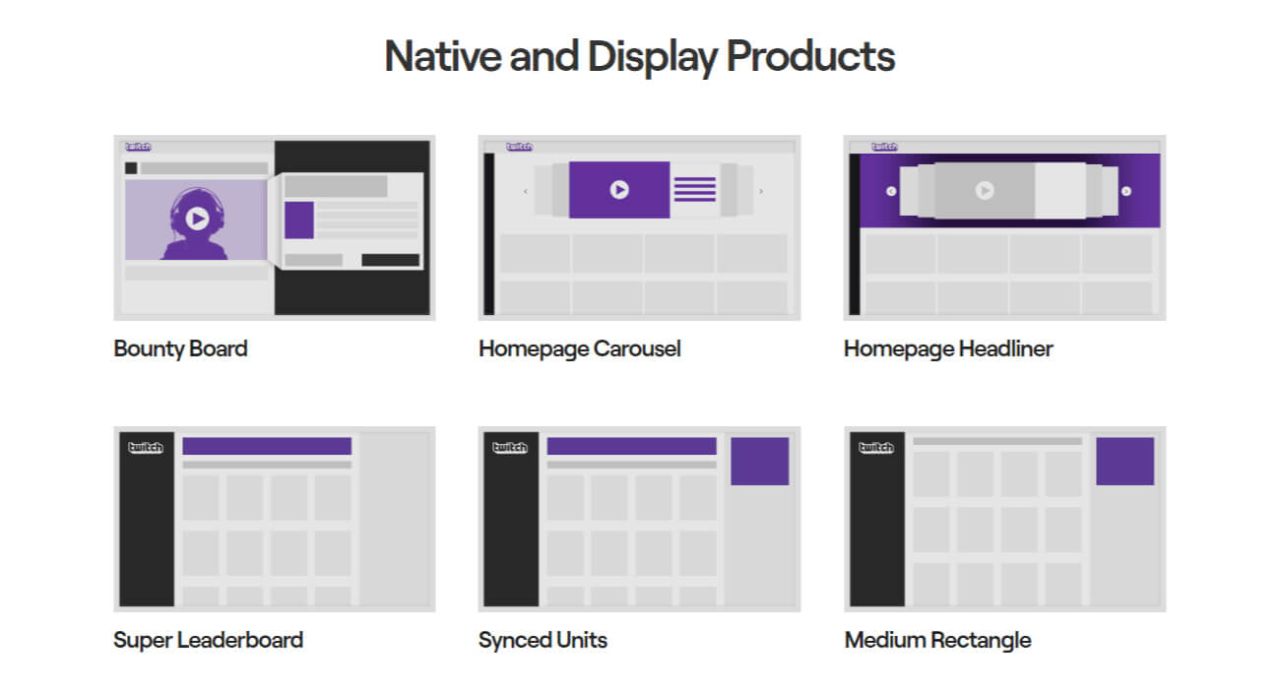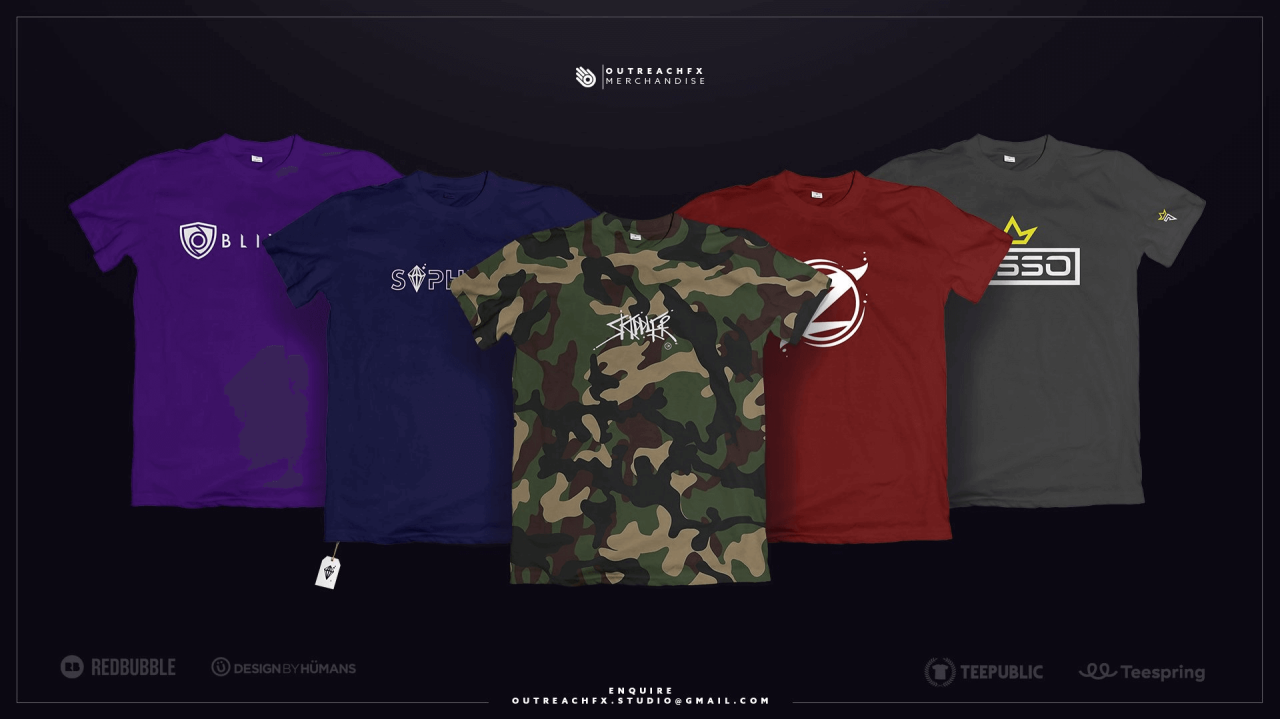How Much Money Can You Make from a Mobile App in 2022?

The mobile app market is expanding every day, and the revenue generated by the mobile app industry is breaking all records. This trend is causing many companies to think about going mobile and launching an app to make more money. But is it really possible to make money from a mobile app, and how exactly can you perform that? Let’s get straight to that issue.
Here’s What We’ll Cover
Most Used Monetization Methods for Mobile Apps
If you’re planning to launch an app, keep in mind that not all app categories are equally profitable.
Below, you will find statistics about the most profitable methods of monetizing mobile apps in 2021. The data shows that video ads were the most popular app monetization method. Eighty-two percent of app publishers surveyed said they use video ads to monetize their mobile gaming content, and non-gaming app publishers using video ads made up 76% of the total. Display advertising ranked second at 77% for non-gaming apps.

Is It True that Every App Makes Money?
As mentioned above, not all app categories are equally profitable. And without choosing a monetization strategy, you won’t be able to generate income from your app at all.
For a better understanding, let’s divide monetization models into three groups:
- Free apps. This category of apps doesn’t have any paid content. Users install and use these apps for free.
- Partially free apps. Basic functionality is always free of charge. If users want to use additional features, they will need to pay.
- Paid applications. These applications require payment. They usually provide users with a free trial period. Once this period runs out, users will be required to pay a fee.
Now, let’s see how you can make money using each of the payment models.
Popular App Monetization Models: Essential Trends and How They Work
While everything is obvious with paid apps, the monetization of free apps is still a matter of doubt. So, let’s take a closer look at how they can be used to make money.
How Do Free Apps Make Money?
Below, we’ll talk about strategies you can use to make money from free or partially free apps.
Strategy #1: Advertising and Affiliate Marketing
There are several types of affiliate marketing campaigns, so let’s mention the most popular ones:
- Cost per click (CPC). This model means that you will receive payments for every click on the ads displayed in your app. But keep in mind that one click is nearly worthless, and revenue is calculated based on cost per million (thousand).
- Cost per view (CPV). These types of campaigns usually apply to video ads. The more times your app users view a video ad, the higher the payout.
- Cost per install (CPI). In this model, you get paid every time a user of your app installs the advertised app.
There are several ways to display ads in your mobile app:

- Banners. Banner ads often appear at the top or the bottom of a screen. But banners have low click-through rates and rely heavily on brand awareness.
- Native advertising. Native ads don’t look like ads. These ads are seamlessly integrated into mobile apps, making them invisible but highly effective.
- Videos. Typically, video ads appear automatically when users interact with the app.
- Interstitial. These ads take up the entire screen and typically appear when users launch or close the app. Interstitial ads can also appear as pop-up banners.
- Rich media. According to eMarketer, rich media ads show a CTR of 0.44%. Rich media ads use multiple methods to appeal to users, including audio, video, text, and more.
Strategy #2: In-app Purchases<
The in-app purchases monetization method involves integrating native payment gateways of app stores, as such stores charge 3% on every in-app purchase.
With this app monetization model, you can sell different types of items, including:
- Consumables are items that a user can only use once: virtual money or health points, for example. Such in-app purchases are commonly used in mobile games.
- Non-consumable items are features that users buy for permanent use—for example, additional functions or ad blockers.
Strategy #3: Subscriptions
Statistics show that it allows app owners to earn 50% more money per use than any other type of monetization. The paid subscription model works better for apps with high user engagement, such as productivity apps, educational apps, music listening apps, or video streaming apps. All users who purchase an app will pay for it annually or monthly.
But from a development perspective, it’s quite a challenge. To convince users to renew their subscriptions, you should offer more and more information, services, etc. This involves constant changes and updates, and you will have to hire a team to work on your app constantly.
Strategy #4: Freemium
The freemium model is similar to the subscription model. The main difference is that the app user can use the free version of the app with basic features without any time limit. But if users like the free version, they are more likely to opt for the enhanced, feature-rich version of the app and pay a monthly or annual fee.
Strategy #5: Sponsorship
The sponsorship monetization model provides two deal types: share income with a sponsor or receive a monthly sponsorship fee. The main difficulty with this model is finding a sponsor.
You should create a mobile app that is good enough to attract potential sponsors and gain a large number of users. Then you should contact the sponsoring company and make an offer. For example, if they have provided funds, in return you can place their logo on your marketing materials or adapt the overall branding.
Strategy #6: Crowdfunding
If you need to raise additional funds for app development, you can use a crowdfunding platform like Kickstarter, Indiegogo, Crowdfunder, or AppsFunder.
To launch your crowdfunding campaign, you should first create fundraising goals. Then show your app’s potential by crafting your story about your app and the problem it solves. After that, create a clear video and design a campaign page to provide investors with a detailed description of your project.
Strategy #7: Transaction Fees
Payment transaction fees are one more type of mobile app monetization model. In this case, your app serves as a mediator between vendor and buyer. This niche includes not only e-commerce apps, but also flight and hotel booking apps, dog walking apps and meal ordering apps.
You conduct payment transactions and charge a commission for the services provided. Commissions can be paid by the seller, the buyer, or both parties.
For instance, the Airbnb app collects transaction fees for services the company provides. PayPal charges a fee for each transaction, except for personal transactions between PayPal accounts. It can be either a fixed amount or a percentage. The freelance service marketplace Fiverr collects a certain percentage from each in-app transaction.
But note: for charging transaction fees, you should integrate a third-party payment gateway API into your app. This task requires experience in coding, so we recommend hiring mobile app developers.
Strategy #8: Product Licenses
Subscription-based streaming services like Netflix or Spotify buy licensed content from other companies. But Shazam, a sound-recognition technology, is often licensed by other companies to increase revenue streams. So, you can also license your proprietary technology to other companies. For example, data as a product or API as a product are both good ways to monetize digital products that work with data, features, and APIs.
Tips for Choosing the Best App Monetization Model
As you may notice, there are many ways to make money with free apps. You can choose one strategy or several simultaneously. But there are some handy tips to help you monetize your free app in the most effective way.
Consider the Business Goal of the App
Before you start developing an app, you need to be clear about what you’re trying to accomplish in terms of business goals. Is it an attempt to increase brand awareness by getting as many downloads as possible? If so, the paid subscription model may not be the best approach.
If you’re supplementing an existing business with an app, and you have a customer base to reach, a freemium or subscription model is worth considering. For businesses that are only interested in generating quick revenue, the advertising model is the easiest.
Define Your Target Audience
Depending on your target audience, monetization strategies may work differently. For example, gamers will patiently click on video ads to get rewards. But try to implement that with a business tool, and it will be a nightmare. That’s why it’s crucial to define your target audience.
Doing so will also help you identify your users’ exact needs and pain points and ensure high user engagement.
Study Your Competitors and Assess the Risks
Before diving deep into the app industry, find out whom you’re competing with and analyze their strengths and weaknesses to consider possible opportunities. This information will help you define mistakes they’ve made and how you can avoid them to make your free app more profitable and valuable to customers.
Calculate the Economics
Regardless of which model you choose, you’ll need to determine the number of users, conversion rates, average costs, and projected time to profitability.
You will then need to compare these with the current market sentiment and the positions of other competitors.
Monetization and Metrics for Your Model
Sometimes you can combine two or more monetization strategies and define metrics to measure the success of your monetization strategy. For example, Spotify has a conversion rate of 26.6%, but most apps have a conversion rate of 1% on the freemium model. Determine the purpose of your app and track when it hits the market.
Prototyping and User Testing
To have an easy-to-monetize app, you’ll need one that is well-accepted by users. The better way to ensure that is to build an MVP, then test it and gather user feedback on what’s working and what’s not.
Make the necessary revisions based on the feedback and include other ‘nice-to-have’ features. Take note of the engagement factor and if it leads to higher conversion.
What Kind of Apps Are in Demand?
The main factor that affects how much money apps make per download is consumer trends. This means, the greater the demand for a specific type of app, the more you can raise the price. Of course, you should consider that people’s needs are changing.
In 2020, mobile app trends were on-demand, entertainment, news, and information apps. 2021 trends were slightly different. At the top of the market are product- and media-sharing apps, as well as community support, augmented reality, and fitness apps.
In 2022, other types of apps will be in demand. For instance, there may be increased demand for healthcare, gaming, social media, or real estate apps. So before you start building and launching an app, be sure to research the trends.
How Do Famous Apps Make Money?
So, let’s take a look at how some famous apps make money.
How Does Instagram Make Money?
Instagram has an in-app advertising model. Users get targeted ads in news feeds and stories. You can tell which ones are user-generated content and which ones are ads by the “sponsored” tag.
How Does Twitch Make Money?
Twitch makes money from the following sources:
- Advertising. Twitch offers dynamic options like IAB display, video media, native opportunities, and entirely custom executions. It allows different gaming companies, portals, and developers to obtain a highly targeted audience base that is addicted to video games. Twitch’s CPM prices are very seasonal, which is why they change frequently from $2 to $10 for every 1,000 views.

- Subscriptions. Twitch offers a Turbo membership for $8.99 per month, which allows ad-free viewing of Twitch content.
- Partner Program. The Twitch Partner Program is an exclusive plan for those who are committed to streaming and are ready to level up from Affiliate. This option attracts many talented gamers to the platform. It ultimately results in increased revenue for Twitch.

For example, if Twitch partners with a T-shirt company, this enables the most popular gamers to create their own T-shirt designs, advertise them during streams, and receive a share of the revenue from sales.
How Does Slack Make Money?
Slack adopts a freemium model to burst its business while engaging new users. The limitations of a free account don’t affect the user as they start using the platform. But once Slack becomes an essential part of their workflow, users can upgrade the app to get access to advanced functionalities.
Slack combines the free model with a direct sales force to acquire enterprise customers, with yearly recurring revenue of over $100,000. Those customers were 575 in 2019, and they accounted for 40% of its revenues.
How Does YouTube Make Money?
As you probably know, YouTube’s main source of income is advertising, as well as premium subscriptions that allow users to get rid of ads and access its music app.
How Does Netflix Make Money?
Netflix operates on a subscription-based revenue model, and it has a huge number of subscribers who pay from $8.99 per month to $15.99 per month.
We hope the above list of app monetization strategies will inspire you to find alternative approaches that will set you apart and create a competitive advantage. And if you need business analyst support, just contact us. We know what it takes to get a product to start generating serious revenue—and how to build it properly.




